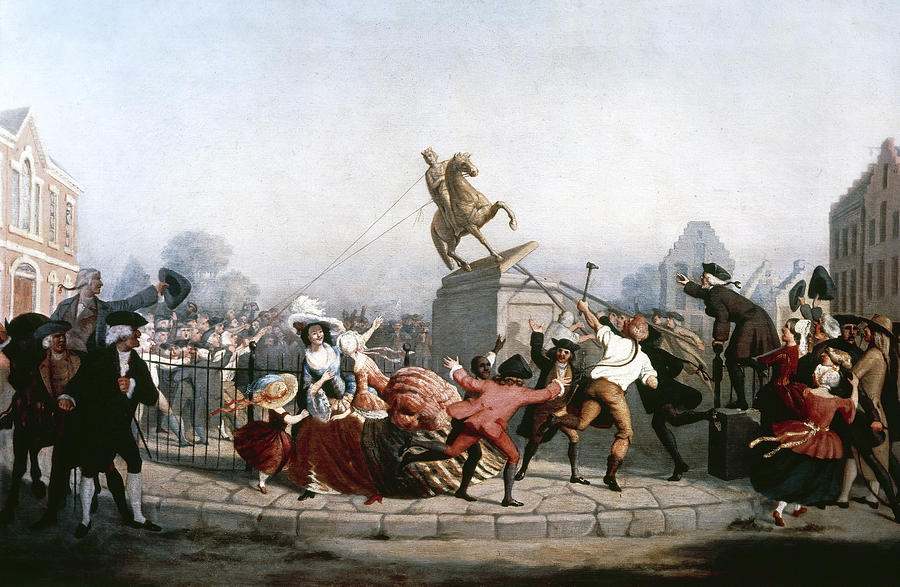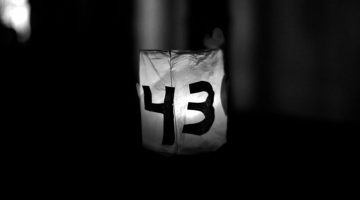Headed For Extinction
It was 1991, and Marie-Josèphe Rose Tascher de la Pagerie, the French Creole mistress-turned-Empress to a “piggish” upstart Corsican artillery officer better remembered as Napoleon, had just been guillotined in an overdue form of people’s justice. The monument to Joséphine Bonaparte erected in 1859 had been standing in La Savane Park, Fort-de-France, Martinique for nearly 150 years. Now it stood as a headless effigy of sculpted stone, complete with faux arterial blood dripping from her cleft neck. In a clandestine act of reclaimed power reminiscent of the French Revolution’s Reign of Terror, Joséphine’s execution became the ceremonial embodiment of dissent turned to boil; she was sacrificed unto the memory of black suffering and anger. This uprising symbolized the undignified ending of a self-made Empress that had been centuries in the making. What was once a memorial was now an altar in the struggle for historical meaning. A reminder to all those who might, will, and do see it: we are here, and you are mother no more. This moment of reclamation begins with murder, a resounding sentiment that says, “as the Caribbean bleeds, so too shall France.” In the poli-tricks of meaning, where cultural and physical domination are paramount, their undermining is both vulgar and nuanced. Is that not the commonsense definition of art itself?
Since her beheading Joséphine has had good company in posthumous execution. Most recently she’s been joined by Padre Junípero Serra, an 18th century Californian missionary who was then in the process of being canonized. Protests by indigenous California tribes confronted the call for sainthood, referring to Serra as an arbiter of colonialism, and father to the slavery and genocide of California Indians. In the wake of the activism surrounding Pope Francis’s visit to California to finalize Serra’s canonization in September of 2015, enterprising dissidents took it upon themselves to clandestinely visit the San Carlos Borroméo de Carmelo Mission in Carmel, California to topple his statue and “decorate” the headstone of Serra’s grave with red and green paint. Two weeks later another statue of Serra, built in 1891 and standing in the heart of Monterey’s Presidio was beheaded. The head has yet to be recovered.
According to estimates provided by the city of Monterey, the cost to fix the monument is $70,000. Meanwhile, California Indians have been illegally dispossessed of their lands by the state and federal governments, who conveniently failed to ratify any of the 18 treaties negotiated with California tribes by simply leaving the unsigned treaties in a drawer for over 50 years and ignoring them. These treaties remain unratified and the settler population has expropriated 50 million acres of land. The case of the treaties remained in litigation for nearly a hundred years (50 years in a drawer included), only to result in a 1968 settlement offer of 47 cents an acre, and the legal forfeiture of all further awards or future claims in perpetuity should anyone actually cash the checks sent to them. By comparison, $70,000 in damages is a bargain. Try losing 50 million acres of your land, your tribal autonomy, or as with a third of California tribes, the ability to be recognized as a tribe by the very state and federal governments who stole and occupied your land in the first place. What’s a can of paint and a headless statue compared to that?
The Architecture of Meaning
In January of 1874 the then-teenaged future head of Hearst Publishing, Solomon Solis Carvalho, described in Harper’s Magazine the Fort-de-France public square around Joséphine as being watched over “. . . by a beautiful statue of the Empress [her] head turned to . . . the place of her birth . . . her eyes [trans]fixed as if absorbed in thought.” A site that is “a favorite resort for all classes . . . [that] affords a delightful promenade for lovers who may there breathe their tender thoughts without fear of intrusion.”1 A hundred years prior, slavery had been abolished in all French colonies, except Martinique—under the supposed prodding of Emperor Bonaparte by Joséphine. Never let it be said she didn’t reward her slave owning plantation family roots on the isle. Did the slave enjoy tender thoughts, without fear of intrusion?
When she was beheaded in 1991, none other than the father of Négritude, poet, and arch-anticolonialist Aimé Césaire was mayor of Fort-de-France. The audaciousness of symbolic public execution was an act of profound political insight . . . it sent a clear message that there would be no turning back. Today, over 20 years later, the monument remains headless and has become a bit of a pilgrimage site, upon which people urinate, defecate, and leave messages expressing exactly how they feel about Joséphine, French Colonialism, and slavery. At the end of what would have been her sightline is the plantation where Marie grew up, preserved as a museum dedicated to the “Empress of the Caribbean” for tourist consumption; the celebration and its negation coexist simultaneously. No one said that spectacle need be free of irony or absurdity . . . off with their heads, indeed.
Though Joséphine’s end has predated a series of recent events, it’s also in tune with a long tradition of toppling and reconfiguring icons for the ever-ravenous audience of the republic. In 1992, a year after the uncrowning of Joséphine in Martinique, indigenous Maya and Zapatista rebels marched into the colonial city of San Cristóbal de Las Casa, Chiapas, Mexico, during the “Day of the Race” demonstration. They reached the baroque temple of Santo Domingo and toppled the life-sized monument to conquistador Diego de Mazariegos, bound it in ropes, dragged it through the streets of San Cristóbal, smashed it to bits with a sledgehammer, and carried off the head to places unknown. The symbol of their colonial oppression was excised like a cancer, and violently reborn as an act of overdue retribution and liberation. This action became a central component in the public outcry and outrage that spread through Mexico.
On New Year’s Day of 1992, when the armed wing of the Zapatista movement, the Zapatista Army (EZLN), emerged out of the mists of the Lacandon Jungle and marched into San Cristóbal and took over the city, it sent shockwaves around the world. The official line of Distrito Federal, the capital city of Mexico, had long been one claiming that no such dissent existed in their perfect neoliberal state. With flash and theatrics reminiscent of the Mexican Revolution, an army of masked Mayans and Mestizos led by a council of militarized women and men with noms de guerre like Comandanta Ramona, Comandanta Esther, and Subcomandante Marcos sent out a message of self-determination and freedom. The fall of Mazariegos nearly a year later was the natural byproduct of this movement toward resurgent insurgency, and its critique of the “history as we knew it.” The new call to arms and action was now: ¡Para Todos Todo, Para Nosotros Nada! (Everything for Everyone, Nothing For Ourselves!). Gone was a willingness to accept monuments to entitlement, misery, death, and bondage to a history in which self-definition was eliminated, and amnesia required. The revolutionary was again reborn, and
s/he spoke in tongues that predated Columbus and the arrival of predatory European encroachment.
Of Vandals, Demagogues, and Toppled Giants
In April of 2003, the U.S. Army’s experts in Psychological Operations set the scene by hiring non-Iraqis to participate in the theatrical end of the Battle of Baghdad, and theoretically at least, the second U.S. War with Iraq. Within minutes of the bronze statue of Saddam Hussein being pulled down in Baghdad’s Firdos Square, surrounded by a throng of supposedly Iraqi nationals welcoming the symbolic fall of their resident despot, it would be broadcast on every television worldwide. The only problem was, none of it was true. The crowd wasn’t Iraqi, the statue didn’t come down easily, and it took multiple and varied attempts (and reshoots) to artificially create this seamless media moment.
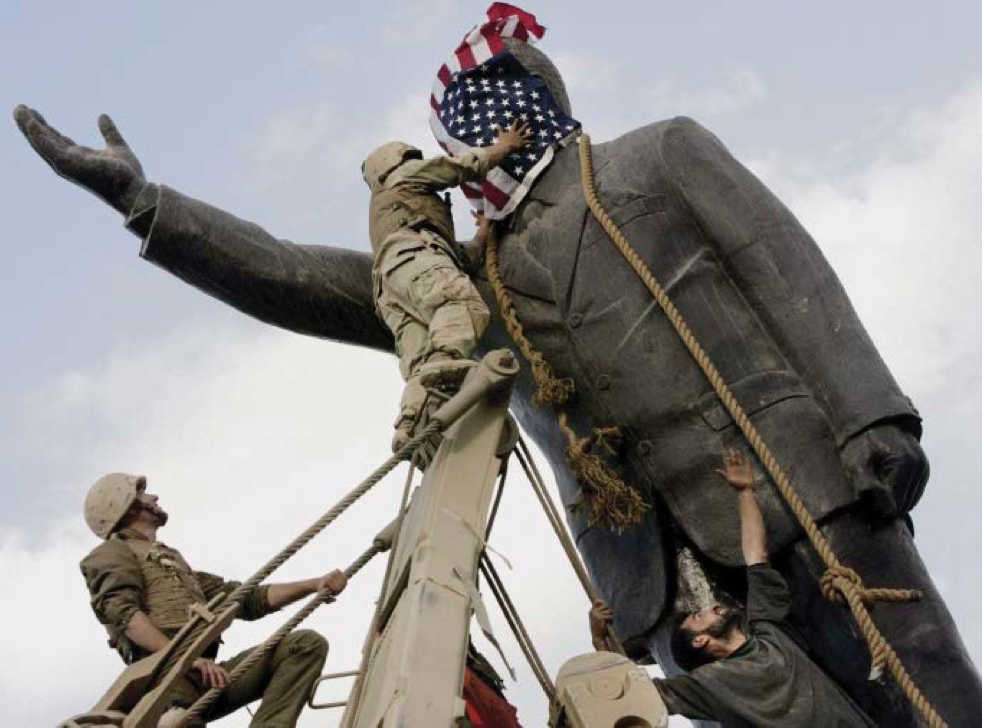
A statue of Saddam Hussein being toppled in Firdos Square, downtown Baghdad, on 9 April 2003.
At first U.S. Marines climbed the statue in order to wrap the head in an American flag, take pictures and start the toppling. Then someone realized that perhaps it was not the best idea, as “it might send the wrong message,” so the American Flag was replaced by an Iraqi flag, it was supposed to be a war for their freedom after all. But oops, the picture shouldn’t be of a U.S. Marine putting up the Iraqi flag, it should be an Iraqi putting up the Iraqi flag—too bad there weren’t any Iraqis around willing to do it, or even to participate in the staged affair. The next idea was to tie ropes around the statue, and pull the statue down. Too bad there were eight-foot-long steel support beams running up the hollow legs of the nearly 20 foot tall statue, which itself was made out of an alloy composite of bronze and steel. Pulling the towering figure down by hand was simply impossible. Bright idea, let’s tie the ropes to a tank! Nope, bad idea, the ropes snapped. Eventually a chain, attached to a crane, attached to an armored vehicle, was wrapped around the statue, and “American ingenuity” toppled the Scud-dropping scourge of the Middle East. It only took several hours, multiple takes, and several million dollars in wages, bribes, and military equipment to make the magic of perceived “Iraqi freedom” happen. That is until the insurgency that couldn’t and never would happen, actually did, and it made it impossible for American troops or Iraqi civilians to walk through central Baghdad without some kind of escort or safety plan. But that’s another story.
The Psychological Operation Group of the U.S. Army understood all too well that symbols and perceptions matter, so they should be taken control of and directed before someone else does it. They and their allies in the “Coalition of the Willing” made it a priority in fact. From embedded journalists to pounding heavy metal invasion videos on YouTube, the exhibitionism of shock and awe took center stage. The visuals, like the message of a patriotic war for freedom was a prepackaged affair. Even the British got in on the game, staging photo ops of the victory with the Union Jack, which hadn’t flown over an “occupied” Iraq since 1932. Command over image meant either making falling idols, or becoming one. The difference between the spectacle of dissent as controlled entertainment, and reclamation isn’t so much a fine line, as it is diametrically opposed to and in direct conflict with one another.
Thus the art of reclamation is an insurgent act by which meaning is transformed, reasserted, and violently juxtaposed upon the symbolic physical and social body of itself by the very people for whom the objet d’art is intended to pacify, through the capture, control, and manipulation of their imagination, memory, and present. This toppling of the figurative head, is indeed the toppling of giants. The Colossian comeuppance if you will, this Fanonian retrieval of selfhood, dignity, power, and prank all rolled into one. It’s a collaborative psychosocial act that, like the breaking of one’s slave shackles, is the apex of renewal, rebirth, and absolute even absurdist potentiality. The lifecycle of public art—its alteration, destruction, and even disappearance—is like the sweat and blood of making the art itself.
Subliminal And Not So Subliminal Revolt
In Caracas, Venezuela on October 12, 2004, what used to be celebrated as Discovery Day was renamed the day of Indigenous Resistance. The next day, the body of Cristóbal Colón was pulled down from the perch where he had stood for a hundred years, and fell 30 feet to the asphalt below. The crowd of protestors wrapped the statue in banners, tied a noose around Colón’s neck and dragged his clanging metal body through the streets of central Caracas. Demonstrators said it was an “act of symbolic justice” for a people against whom this monument, “represented [the] invasion and genocide [of] our land.” For some, like Mayor of Caracas, Freddy Bernal, this action represented the kind of discordant activity he couldn’t condone. He referred to it as an “anarchic action [that does] not accomplish one possible objective. We agree that history has to be rewritten and we are doing it. We reject honoring Columbus, but that is one thing, and anarchy is another.”2 Bernal was wrong: it most definitely accomplished more than one possible objective, not the least of which was catching his own and Hugo Chavez administrations’ attention, and the significant applause of the indigenous peoples of the Western Hemisphere.
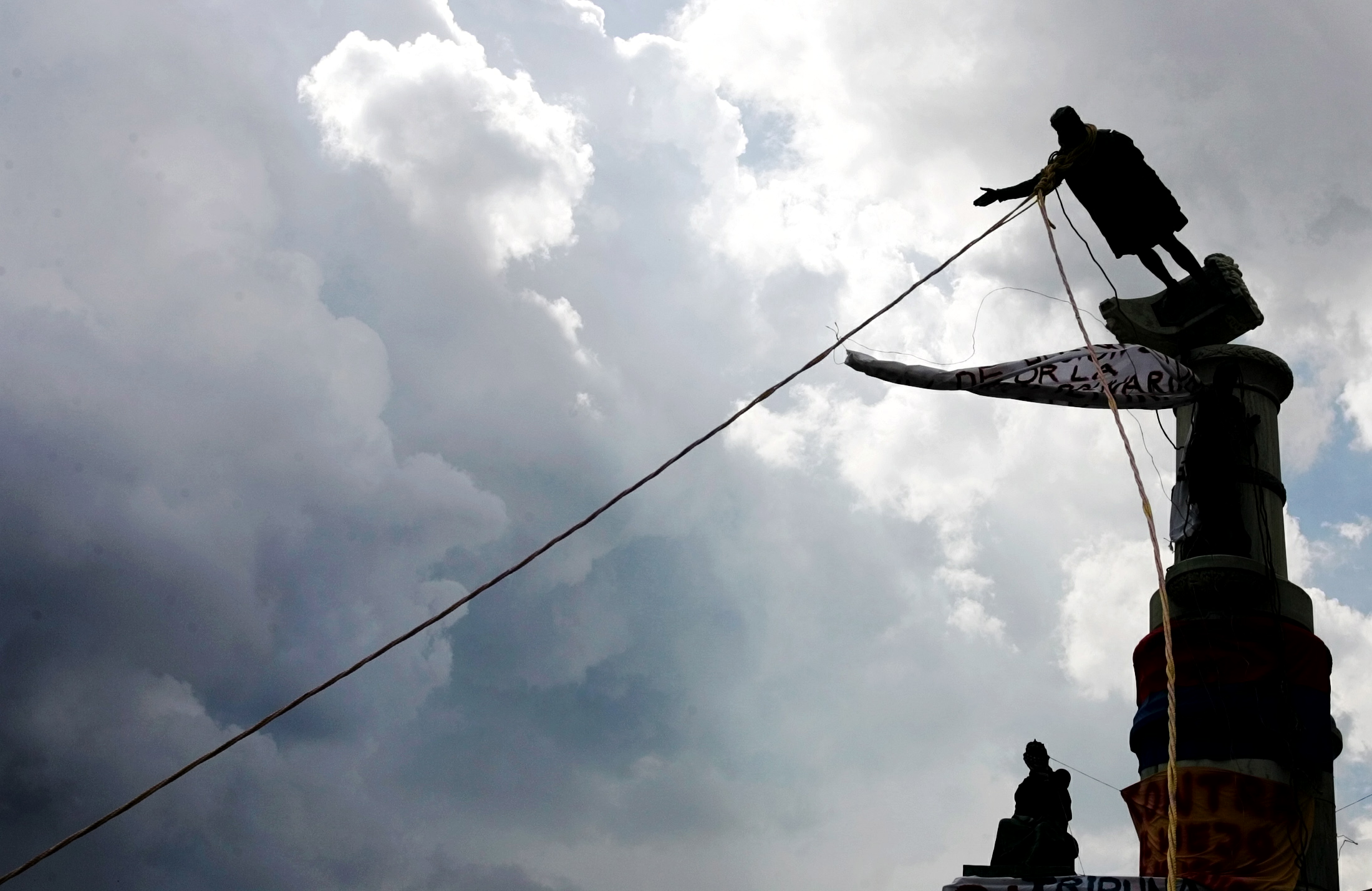
Venezuelan demonstrators topple Columbus Statue, 2004. Courtesy of the Internet.
In the following decade, a wide variety of monuments to despotism and self-serving historical grandeur were greeted in kind by the social force of a mass historical revisionism driven by the people. During the Arab Spring, an Egyptian monument on the road into Cairo was continually remodeled through use of sledgehammers, explosives, and firearms, so that deposed Egyptian President cum dictator Hosni Mubarak existed on it as a gaping crater where his face used to be. In 2014, waves of spatial and historic reclamation spread through South Africa and Kenya. Monuments to King George, Queen Victoria, Cecil Rhodes, and King Leopold were laid siege. They were covered up, vandalized, painted over, maimed, beheaded, defaced, covered in excrement and piss, and used as the stage for speeches encouraging their removal and demolition. King Leopold’s ghost and its brethren were being resurrected and beaten down by the popular anger of a generation intolerant to any further celebration of the Scramble for Africa, or Apartheid-era echoes of European Colonialism.
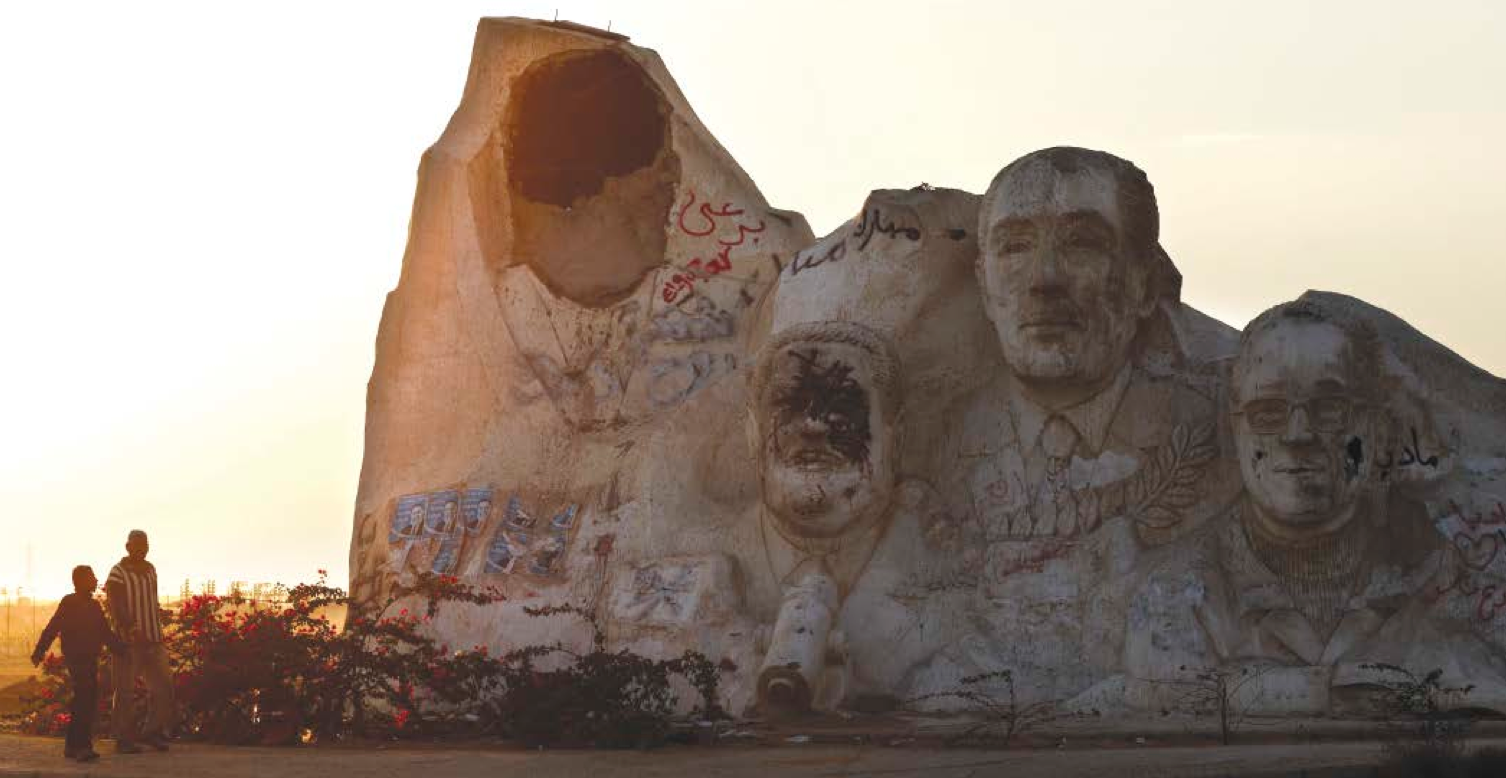
A giant statue of former Egyptian President Hosni Mubarak (left) on the outskirts of Cairo, Egypt. Also depicted; Egyptian Nobel prize winner Ahmed Zewail, the late Egyptian President Anwar Sadat and Egyptian novelist and Nobel Prize Winner Naguib Mahfouz. Courtesy of the Internet.
By 2015, the phrase Black Lives Matter had become the primary slogan by which the growing popular movement against the murder, violence and injustice faced by black people in the U.S. became known. The volume of its militancy and its message grew with every exposure of the daily repression to be found in the experience of blackness in post Civil Rights era America. Never more so than following the massacre of nine black men and women in Charleston, South Carolina by pro-Boer, pro-Apartheid, White Supremacist Dylann Roof. Monuments to the Confederacy and Jim Crow South came under progressive assault by dissident voices calling upon the public to rethink, and reimagine the meaning of what their preservation means. In traditionally Republican strongholds like Texas, statues of Robert E. Lee and Jefferson Davis were defaced. By the end of the year, cross-racial alliances between black and Indigenous activism became central to reclamation acts nationwide. In October, Detroit residents woke up to a bloodied bust of Christopher Columbus with a hatchet buried in his head.
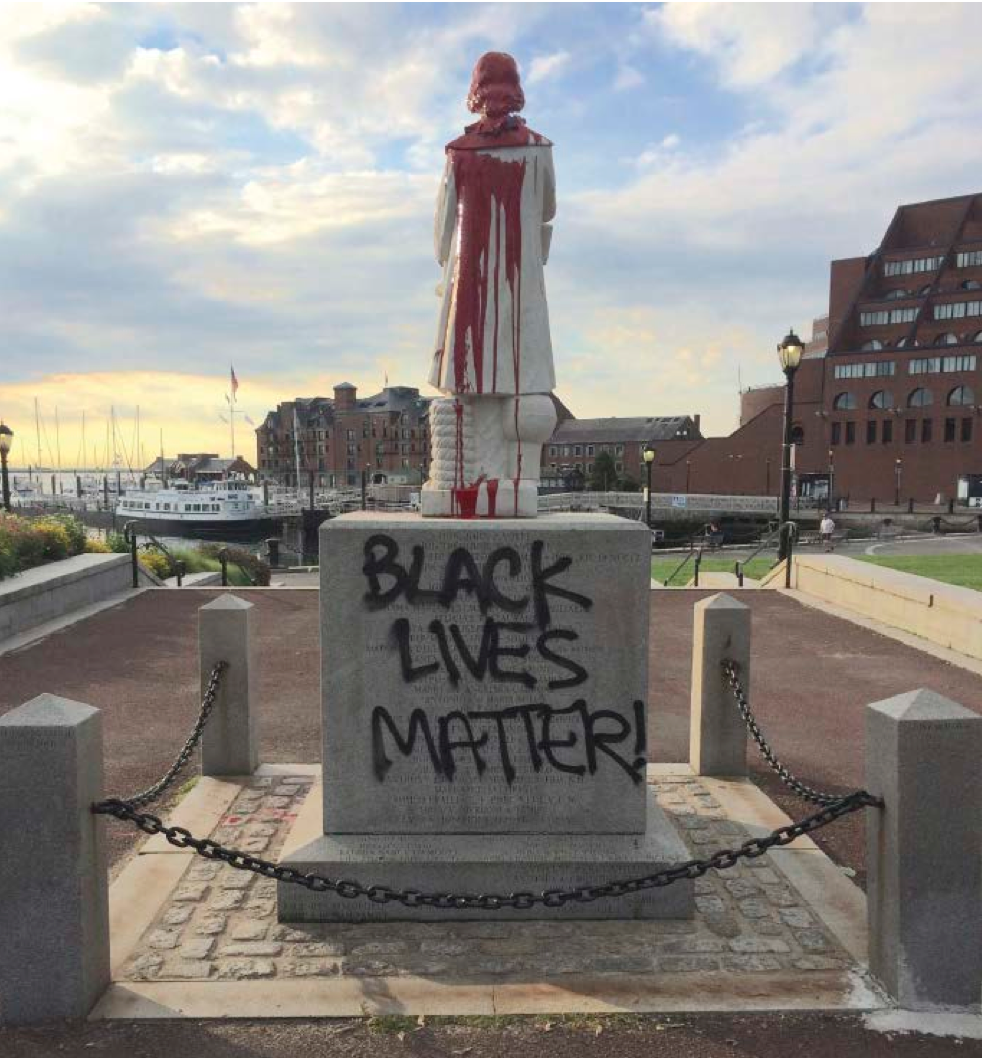
Christopher Columbus statue on the North End waterfront, Boston. 2015. Courtesy of the Internet.
The New Year started off with a bang, as early in January of 2016 in the U.S. Colony of Puerto Rico, independentistas altered the statues that make up the six-year-old, $987,000 Paseo de los Presidentes bordering the Puerto Rican Capital Building in San Juan. The monument depicts the nine presidents of the United States, including Barack Obama, who have visited the island nation. The eyes, stomachs, and foreheads of Herbert Hoover, Teddy Roosevelt, Harry Truman and Franklin D. Roosevelt were now painted over in blood red, and the word “Assassins” painted in front of each of them. Puerto Rican Senator, José R. Nadal Power, asserted that acts such as these were an outrage, and that “all protests and expressions must occur within the limits of legality and respect.”3
That a senator can still say such a thing when the history of Puerto Rican repression and resistance involved the Ponce Massacre of 1937, in which police murdered 19 peaceful protestors and wounded two hundred other demonstrators, boggles the mind. Or, when Puerto Rican hero Pedro Albizu Campos, the first Puerto Rican to attend Harvard Law School (joining a very short list of black firsts at the university), can be executed by slowly being experimented on and irradiated to death while incarcerated in a U.S. controlled prison in 1965. Or when the likes of Lolita Lebrón and her comrades can open fire in the U.S. House of Representatives in 1954, wounding five members of Congress. Or when the Fuerzas Armadas de Liberacion Nacional (FALN), can bomb a U.S. airbase, resulting in the destruction of eight fighter jets and multiple millions of dollars in damages. Or when targeted assassinations of Puerto Rican Nationalists were orchestrated by the FBI throughout the majority of the 20th century, and continued into the present millennium with the open murder of Filiberto Ojeda Ríos of the Macheteros in 2005. Exaggerated statements by the likes of Nadal Power are not only ridiculous but also exercises in historical amnesia.
It’s only paint, not a mass terror attack. The feud between the rhetorical musings of the latest in trending sound-bytes and the quest for hegemony over popular memory continues. After all, it’s an American tradition: following the first reading of the Declaration of Independence in 1776 to the citizens of New York, George Washington and his troops, along with a frenzied mob of soldiers and New Yorkers, rushed to Bowling Green Park in Manhattan and tore down the lead statue of a horse-mounted King George III of England, later melting it down into musket balls for use in the coming Civil War with England. ‘Murica, Fuck Yeah!
1) http://harpers.org/archive/1874/01/rambles-in-martinique
2) http://venezuelanalysis.com/news/734
3) http://waragainstallpuertoricans.com/2016/01/13/u-s-presidents-are-vandalized-and-called-assassins-in-puerto-rico/
